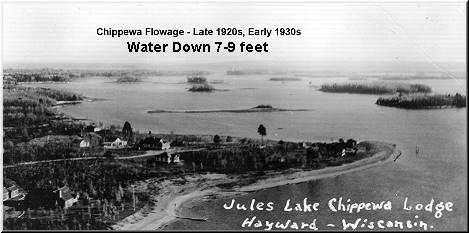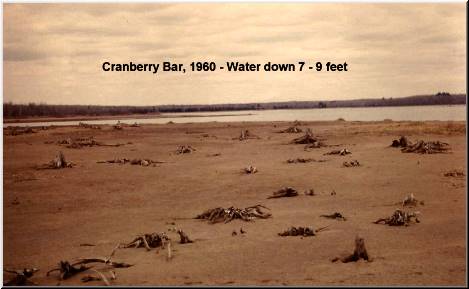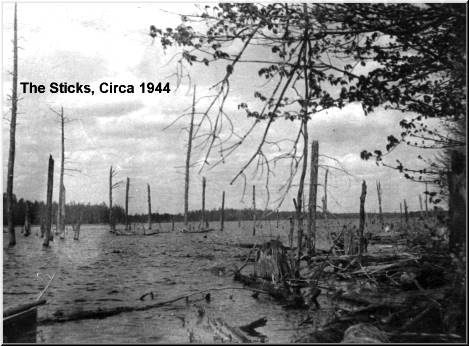Obviously, extreme drawdraws like we
had during the early years (the 1920s and 30s) had some serious
consequences, isolating fish in small pools or sections of the
Flowage where they died due to a lack of oxygen. In some
instances, men like John Weidman were hired to dig trenches from
some of these pools so they would connect with deeper water
sections and streambeds to allow the fish to migrate to safety.
These drawdowns were most extreme in 1925, 1926, 1928, and 1931
when the Flowage was dropped more than 24 feet, nearly back to
the levels of the original river and lake system. After 1939
consistent extreme drawdowns were halted; between 1940 and 1971
drawdowns fluctuated between 11 and 23 feet down (averaging
around 15 feet); and from 1971 thru 1997 more moderate drawdowns
in the 8 to 14 foot range were utilized. The moderate drawdowns
of this later period proved to be very beneficial to the health
of the Flowage’s fishery while at the same time not being so
extreme as to isolate and kill significant numbers of fish.

Arthur Oehmcke, one of the State’s
most well-known and accomplished fish culturists, was present on
the Chippewa Flowage working its hatchery at the Winter Dam
during the late 1930 and 1940s and remained intimate with the
fishery of the Flowage during the years that followed. Although
Oehmcke agreed that it was a good thing that the extreme
drawdowns of the early years ceased, he empathically stated that
the more moderate drawdowns were good for the Flowage in that
exposing the bottom sediments created oxidation which in turn
released the much needed nutrients into the ecosystem of the
Flowage. These nutrients, forms of zooplankton known as
crustaceans - more specifically referred to as "water fleas"
(Daphnia, Cyclopes, and Polyphemus) - are the critical forms of
feed that newly hatched fry need to survive for the first two
weeks of their lives after they lose their food sac and become
free swimming.



These free swimming fry are too small
to subsist on small minnows, rather they must forage on the tiny
water fleas - which are the size of pepper - to survive. For
decades, this is what gave the Chippewa Flowage an enormous
edge, especially to it musky and walleye recruitment numbers.
Because of the drawdowns and the resulting oxidation and
significant nutrient releases of water fleas every year, the
Chippewa Flowage had some of the highest recruitment numbers of
musky and walleye in the State. During the past 10 or 15 years
however, these recruitment numbers have been low for both musky
and walleye…. very likely because their newly hatched fry have
had much less natural food (water fleas) to eat.
Naturally, there is pro and con to
whatever drawdown that is utilized; however, I firmly believe
that the pros greatly outnumber the cons regarding a moderate
Winter drawdown. Years ago, during the more moderate
drawdowns, in addition to having higher populations of young
musky and walleye, the crappie averaged much larger and the
bluegill population was considerably less…. a much better
circumstance to sustaining healthy walleye and musky
populations. Keep in mind: although bluegill are fun to catch,
allowing a lake to overpopulate with stunted growth bluegill can
seriously threaten newly hatched walleye and musky fry.
As far as bass go: the smallmouth bass
seem much less affected by drawdowns as they seek out deeper
water during such periods. Largemouth, however, are more likely
impacted by moderate drawdowns so their numbers would also
likely drop to some degree. But remember, because (like the
bluegill) they are not a friend to walleye populations, it is
best for the health of the walleye fishery - and probably the
musky fishery as well - to keep largemouth populations in check.
The benefit of reducing largemouth bass populations though, is
that it is likely to improve the size structure and growth
potential of the bass that remain.
So the stage is set with this Winter’s
drawdown to help increase the musky and walleye recruitment
numbers in two ways: first, to give our newly hatched musky and
walleye fry much more food to eat and, secondly, reducing the
number of predators that are waiting to gobble them up.
Much has been said about the benefits
of a Winter drawdown combating and reducing the ever growing
problem with Eurasian milfoil, an invasive species. The
abundance of Eurasian milfoil is a concern because it negatively
impacts boating and fishing and – as it dies out under the ice
during the Winter – contributes to increased oxygen depletion
and, ultimately, increased fish kills. The greater the weed
build up that a body of water has, the more likely it is to have
oxygen deprivation issues during the coming Winter season. So it
is in the best interest of the Chippewa Flowage to do our best
to combat the excessive milfoil growth.
Eurasian milfoil is not the only
undesirable weed in the lake. There are many other types of
"junk weeds" that negatively affect the fishery as well.
Furthermore, excessive weed buildups can form a matt of decaying
material on the lake bottom and increase the rate at which the
bottom will muck up or silt over – a situation that can not only
speed up the aging process of a lake but seriously threaten the
viability of good spawning habitat.
Thankfully, because the Chippewa
Flowage is a reservoir and its water level can be controlled,
there is something we can do about this weed issue. By allowing
a moderate drawdown of 8 to 10 feet, most of the lake bottom
that grows the Eurasian milfoil (and other "junk weeds") will be
exposed and the Winter’s hard freeze will greatly contribute to
freezing out the roots of the Eurasian milfoil… giving milfoil
much less of a presence during the following summer season.
Although drawdowns on the Flowage have proven to greatly reduce
Eurasian milfoil and other "junk weeds" during the following
season, it has done little to harm the good quality weeds that
we like to see. Quite the contrary, after a moderate drawdown we
usually have very good quality, desirable weeds but yet much
less Eurasian milfoil and "junk weed".
The upside to having a moderate
drawdown in the 8 to 10 foot range is that a high percentage of
the Eurasian milfoil growth will not even be in water as it
decomposes, rather it will die sandwiched between the ice cover
and the lake bottom. Therefore removing these dying weeds from
the "water equation" greatly reduces potential oxygen
deprivation and thus minimizes potential fish kills.